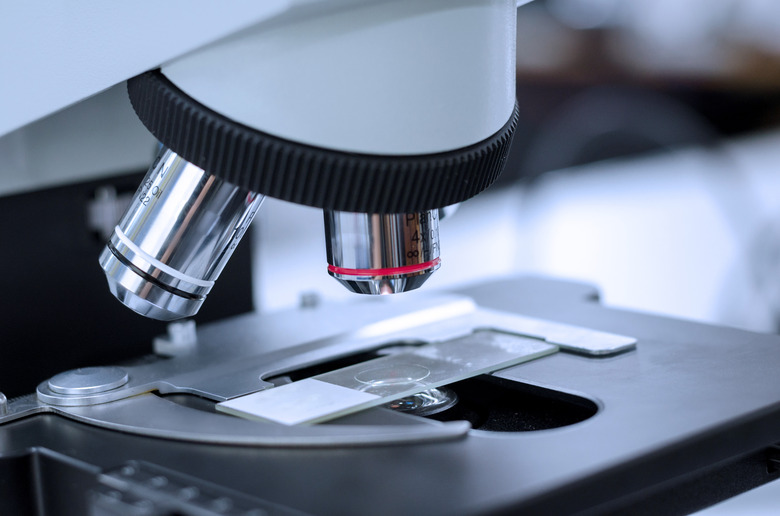What Happens When You Go From Low Power To High Power On A Microscope?
When you change from low power to high power on a microscope, the high-power objective lens moves directly over the specimen, and the low-power objective lens rotates away from the specimen. This change alters the magnification of a specimen, the light intensity, area of the field of view, depth of field, working distance and resolution. The image should remain in focus if the lenses are of high quality.
Change in Magnification
Change in Magnification
Changing from low power to high power increases the magnification of a specimen. The amount an image is magnified is equal to the magnification of the ocular lens, or eyepiece, multiplied by the magnification of the objective lens. Usually, the ocular lens has a magnification of 10x. A typical lab-quality standard optical microscope will usually have four objective lenses, running from a low power of 4x to a high power of 100x. With an ocular power of 10x, that gives the standard optical microscope a range of overall magnification from 40x to 1000x.
Light Intensity Decreases
Light Intensity Decreases
The light intensity decreases as magnification increases. There is a fixed amount of light per area, and when you increase the magnification of an area, you look at a smaller area. So you see less light, and the image appears dimmer. Image brightness is inversely proportional to the magnification squared. Given a fourfold increase in magnification, the image will be 16 times dimmer.
Field of View
Field of View
Going to high power on a microscope decreases the area of the field of view. The field of view is inversely proportional to the magnification of the objective lens. For example, if the diameter of your field of view is 1.78 millimeters under 10x magnification, a 40x objective will be one-fourth as wide, or about 0.45 millimeters. The specimen appears larger with a higher magnification because a smaller area of the object is spread out to cover the field of view of your eye.
Depth of Field
Depth of Field
The depth of field is a measure of the thickness of a plane of focus. As the magnification increases, the depth of field decreases. At low magnification you might be able to see the entire volume of a paramecium, for example, but when you increase the magnification you may only be able to see one surface of the protozoan.
Working Distance
Working Distance
The working distance is the distance between the specimen and objective lens. The working distance decreases as you increase magnification. The high power objective lens has to be much closer to the specimen than the low-power objective lens in order to focus. Working distance is inversely proportional to magnification.
Oil Immersion
Oil Immersion
Microscopes magnify an object's appearance by bending light. Higher magnification means the light is bent more. At a certain point, the light is bent so much that it can't make it through the objective lens. At that point – usually around 100x for standard lab microscopes – you'll need to put a drop of oil between your specimen and the objective lens. The oil "unbends" the light to stretch out the working distance and make it possible to image at high magnifications.
Cite This Article
MLA
Murphy, Ellen. "What Happens When You Go From Low Power To High Power On A Microscope?" sciencing.com, https://www.sciencing.com/happens-power-high-power-microscope-8313319/. 17 April 2018.
APA
Murphy, Ellen. (2018, April 17). What Happens When You Go From Low Power To High Power On A Microscope?. sciencing.com. Retrieved from https://www.sciencing.com/happens-power-high-power-microscope-8313319/
Chicago
Murphy, Ellen. What Happens When You Go From Low Power To High Power On A Microscope? last modified March 24, 2022. https://www.sciencing.com/happens-power-high-power-microscope-8313319/
